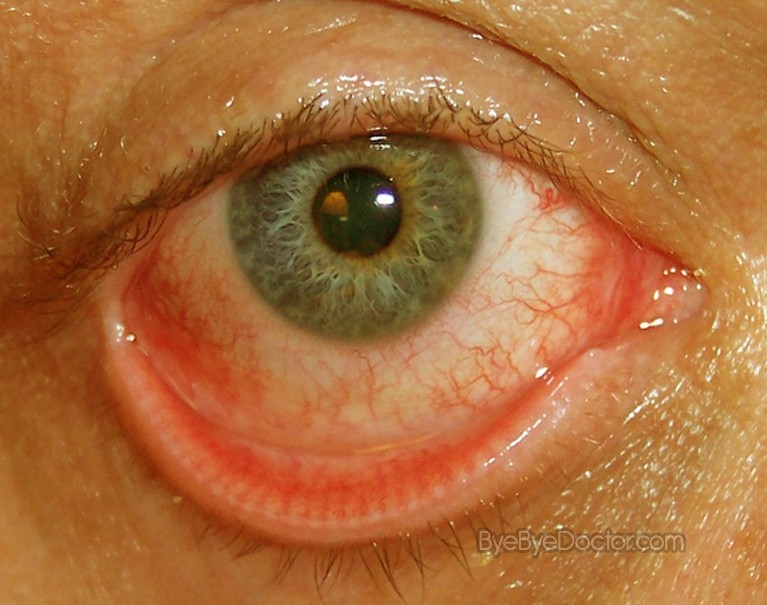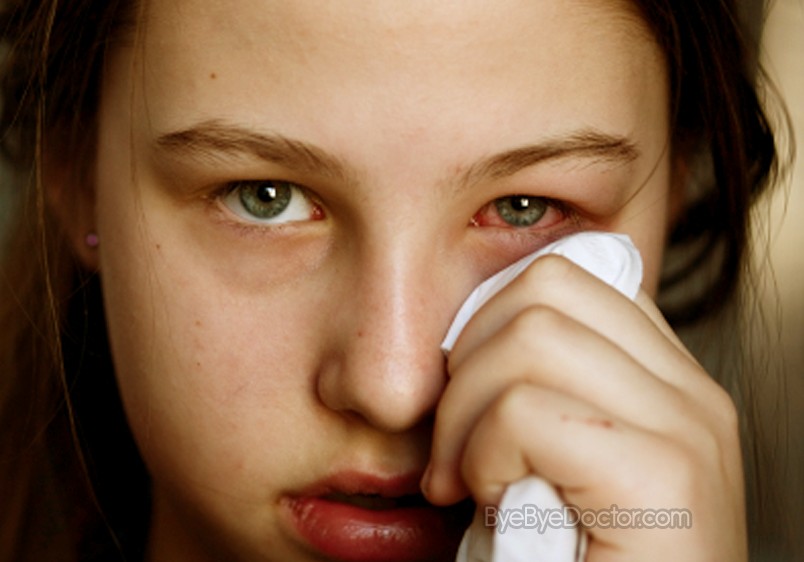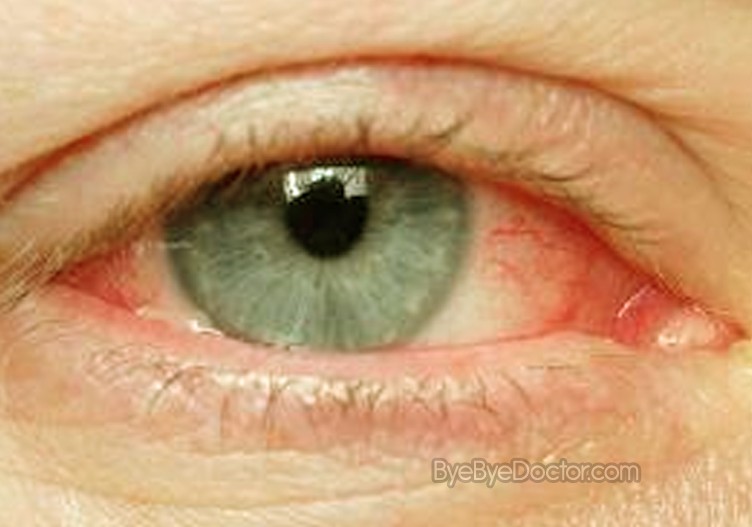Pink Eye
Last reviewed by Dr.Mary on October 4th, 2018.
What exactly is Pink eye?
Pink eye or conjunctivitis is an infection or inflammation of the transparent membrane known as conjunctiva which lines part of the eyeball as well as the lining of the eyelid. Inflammation causes very small blood vessels in the conjunctiva to be more noticeable, and this is what causes the red or pink cast to the whites of the eye – therefore the name “pink eye”.
The reason for the development of pink eye is usually a viral or bacterial infection, allergic reaction or especially in babies, a tear duct that is opened incompletely.
Although the inflammation of pink eye may be very irritating, it will rarely affect the actual vision of the eye. If an individual believes they might have pink eye, they need to take steps to ease the discomfort. But due to the fact that pink eye may be contagious, it is important for early diagnosis as well as treatment in order to help in limiting its spread.
Pink Eye Symptoms
Common symptoms of pink eye consist of:
- Redness in both or only one eye
- Gritty feeling in both or only one eye
- Itchiness in both or only one eye
- Discharge in both or only one eye that can form a crust during the night
- Tearing
It is important to make an appointment with the eye specialist if an individual notices any symptoms or signs that are thought to be pink eye. Pink eye in some cases may be highly contagious for as much as 2 weeks after symptoms and signs begin. With an early diagnosis one can protect people around you from getting pink eye, get treatment in order to help cope with the symptoms as well as reduce any risk of complications.
Pink Eye Causes
Pink eye causes consist of:
- Bacteria
- Virus
- Allergies
- Foreign object in eye
- Chemical splash in eye
- Newborns, tear duct blocked
- Most cases of pink eye are from virus
Bacterial and Viral pink eye
Bacterial pink eye as well as viral pink eye can affect both or only one eye. Viral conjunctivitis normally produces a discharge that is watery. Bacterial pink eye frequently creates a thick, green-yellow drainage. Both bacterial as well as viral pink eye may be linked with the common cold or with indications of an infection of the respiratory system, for instance a throat that is sore.
Both bacterial as well as viral infections are extremely contagious. Children and adults alike may have either of these kinds of conjunctivitis. But, bacterial pink eye is usually found in children more.
Allergic pink eye
This type of pink eye disturbs both eyes at the same time as well as being a reaction to some allergy triggering material such as pollen. When responding to allergens, the body produces antibodies referred to as immunoglobulin E or IgE. This then produces distinctive cells in the lining of the eyes as well as the airways referred to as mast cells which release elements that are inflammatory, including histamines. The body’s discharge of histamine may produce numerous allergy symptoms including pink or red eyes.
With allergic conjunctivitis, an individual can experience very intense itching, inflammation as well as watering of the eyes –and nasal discharge that is watery with sneezing. Most allergic pink eye can be managed with over-the-counter eyedrops for allergies.
Pink eye caused by irritation
Irritation by some splash of a chemical or foreign type object in the eye is likewise linked with pink eye. Often cleaning and flushing the eye to rid it of the object or the chemical causes irritation as well as redness. Symptoms and signs which can include a mucous discharge and watery eyes normally get better by themselves within a day.
Pink eye risk factors consist of:
- Being exposed to any individual with a bacterial or viral pink eye infection
- Being exposed to any allergen that causes allergic pink eye
- Wearing extended-wear contact lenses
In adults and children, pink eye can cause the cornea to become inflamed and that may affect vision in that eye. Rapid appraisal and immediate treatment can decrease any risk of difficulties.
Pink Eye Diagnosis
In order to determine what is wrong with the eye, the eye doctor will examine the eyes. He/she can also obtain a sample of secretions from the eye for analysis in the lab to diagnose what kind of infection the individual may have and what is needed for treatment.
Pink Eye Treatment
Treatment of bacterial pink eye
If the infection is caused by bacteria, the eye doctor can advise antibiotic eyedrops for the treatment of pink eye and this infection will normally be gone within a few days. Antibiotic ointment for the eye rather than eyedrops is often prescribed for the treatment of pink eye from bacteria in children. Ointments are usually easier to manage with young children or infants than are eyedrops, although the ointment can cause blurry vision for as long as 20 minutes after applying it. Using either type of drug will clear up symptoms and signs of pink eye with in a very few days. Always follow the doctor’s instructions and use these antibiotics until the total supply runs out in order to stop recurrence of the infection.
Treatment of viral pink eye
For viral pink eye there is no treatment. The virus only needs time to run its course which is up to 2 or 3 weeks. Viral pink eye normally starts in one eye and then the other eye becomes infected in several days. The symptoms and signs will normally clear up on its own.
Medications that are antiviral can be a decision when the physician concludes that the viral pink eye is from the herpes simplex virus.
Treatment for allergic pink eye
If the eye is irritated by allergic pink eye, the physician can prescribe one of many types of eyedrops on the market for individuals with allergies. These drops can include decongestants, mast cell stabilizers, and antihistamines, anti-inflammatory as well as steroid drops. The severity of the allergic pink eye symptoms can be reduced by avoiding the cause of the allergies when possible.
Home Remedies
In order to help manage the symptoms and signs of pink eye while waiting for it to get better, try this:
Applying an eye compress
Make this compress by soaking a lint-free clean cloth in water and squeeze it out. Then gently apply it over eyelids that are closed. A cool compress can aid in relieving allergic pink eye. If the individual is suffering with viral or bacterial pink eye, a warm compress may be preferred. If pink eye only affects one eye, do not touch both eyes with the exact same compress. This will reduce the chance of spreading the pink eye to the uninfected eye.
Eyedrops
There are many over-the-counter eyedrops referred to as artificial tears which can help to relieve symptoms. Some of these eyedrops can contain antihistamines or other drugs that can help individuals with allergic pink eye.
Do not wear contacts
If you are a contact lens wearer, they may need to be stopped until the eyes are better. How long normally depends on what kind of pink eye you have. If you have disposable contacts, ask your doctor if the lenses as well as lens case and cleaning solution need to be thrown out. If you do not have disposable lenses, make sure the contacts are cleaned thoroughly before wearing them again.
Pink Eye Prevention
Use good hygiene in order to manage the spreading of pink eye. For example:
- Do not touch the eyes with hands
- Use clean washcloth and towel daily
- Wash hands often
- Do not share washcloths or towels
- Throw away eye makeup, such as mascara often
- Change pillowcases often
- Do not share private eye-care articles or eye makeup
Even when symptoms of pink eye can get better in 3 or 4 days, children who have viral pink eye can be communicable for a week or even more. Children can go back to school when they no longer have symptoms of tearing or matting of the eyes.
If a child has bacterial pink eye, keep the child from school while treatment is being started. Many schools as well as child care centers require that the child wait as much as 24 hours once beginning treatment before going back to child care or school. Ask the physician if you have questions concerning your child returning to child care or school.
Preventing newborns from Pink eye
Newborn’s eyes are extremely prone to bacteria normally in the mother’s birth canal. The bacterium triggers no symptoms in the mother. In some very rare cases, this bacterium may cause the infant to develop a very serious type of pink eye known as ophthalmia neonatorum, and needs treatment immediately to protect the eye sight. This is why that after delivery, an antibiotic ointment is normally applied to each newborn’s eyes. This ointment aids in preventing this infection.






